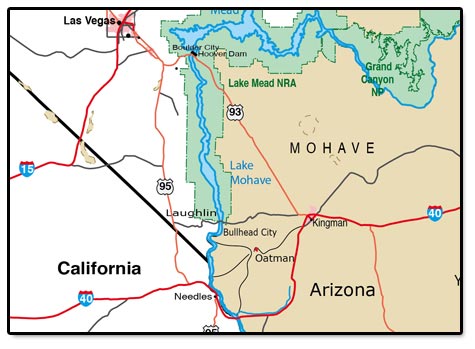October 26, 2010 Bill Williams River National Wildlife Refuge
Yesterday was another beautiful day. We slept again last night with the windows open and had temps in the upper 60's. With the windows open we've heard the coyotes in and around our rig. This morning we found coyote scat about 12 ft from our front door. We're guessing the two we photographed for a previous blog may be with the culprits.
Yesterday morning we decided to take a hike. You see there's this big mountain, a part of the Buckskin Mountains that is in front of our rig that has been calling out to us to hike it ever since we got here!
It's actually across the cove from us. You may be able to barely make out the dirt road beginning at the bottom left of the photo. Anyway this dirt road is used to service the power lines. It's a very steep and rocky road and I've never seen anything drive up but I have seen a jeep come down the road. It's actually off-limits to vehicles with the exception of the power company. Well, yesterday the weather was right with cool temps and overcast skies so Joyce and I decided it would make a nice hike up to the highest power line.
Like I said it's a very steep road and this is one of the better sections. We needed to stop several times along the way to catch our breath!
The views from the top are spectacular. Below you can see the Bill Williams River National Wildlife Refuge compound which contains the administrative building, visitor center, fleet yard and our host sites. The thin peninsula includes the paved nature trail and fishing piers.
In the picture below the green cattails in the upper right (over Joyce's shoulder) is the confluence of the Bill Williams River into Lake Havasu.
It took us about an hour round trip for this hike from our host site. You can just make out highway 95 and the bridge over the river on the right side of the photo below. The majority of the refuge is to the right of the highway paralleling the river.
Mining in the Swansea Area began around 1862, but major activity had to wait for the coming of the railroad. In 1904 the Arizona & California Railroad began constructing a line from Wickenburg to Parker. Seeing an opportunity for further development several of the original miners, Newton Evans and Thomas Jefferson Carrigan, secured investment money and began to develop Swansea.
The trip was 50 miles one way and 17 miles of that was on primitive dirt roads. It's nice to have a Jeep!
By the end of 1908, a 350 ton capacity furnace, a 3.5 mile water pipeline from the Bill Williams River, and the hoists for five mine shafts were under construction. By 1909 Swansea had a population of 500. The following year the Arizona & Swansea railroad began operation from Bouse. The railroad was key in moving supplies and people in and out of the growing mining town. Financial problems set in by 1911 and the mines shutdown with a brief reopening in 1912. The American Smelting and Refining Company bought the mines in 1914 and rebuilt much of the town. The new owners ran the mines until 1937 when the Great Depression closed the mines for good.
There wasn't a lot to see in the abandoned mining town. Just some building and mine shaft foundations. There is a self-guided walking tour and we walked a portion of that before getting bored.
Below are the worker's cottages. The roofs and gables are being restored.
Each of the small rooms are about 10 ft by 10 ft with only a window, a door and a dirt floor.
Little remains in the town from the glory days of Swansea. The townsite has suffered from the weather and vandalism in recent years. You can still see several adobe and brick buildings, the railroad grade, numerous foundations, and the mine shafts. The open mine shafts and tunnels are dangerous and should be avoided.
Before long we called it a day and headed back home enjoying the scenery of the desert on the long dusty ride back.

















































